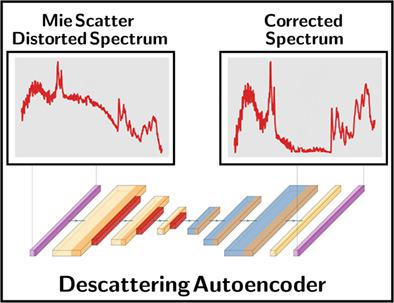当前位置:
X-MOL 学术
›
J. Biophotonics
›
论文详情
Our official English website, www.x-mol.net, welcomes your feedback! (Note: you will need to create a separate account there.)
Deep convolutional neural network recovers pure absorbance spectra from highly scatter-distorted spectra of cells.
Journal of Biophotonics ( IF 2.8 ) Pub Date : 2020-08-25 , DOI: 10.1002/jbio.202000204 Eirik Almklov Magnussen 1 , Johanne Heitmann Solheim 1 , Uladzislau Blazhko 1, 2 , Valeria Tafintseva 1 , Kristin Tøndel 1 , Kristian Hovde Liland 1 , Simona Dzurendova 1 , Volha Shapaval 1 , Christophe Sandt 3 , Ferenc Borondics 3 , Achim Kohler 1
Journal of Biophotonics ( IF 2.8 ) Pub Date : 2020-08-25 , DOI: 10.1002/jbio.202000204 Eirik Almklov Magnussen 1 , Johanne Heitmann Solheim 1 , Uladzislau Blazhko 1, 2 , Valeria Tafintseva 1 , Kristin Tøndel 1 , Kristian Hovde Liland 1 , Simona Dzurendova 1 , Volha Shapaval 1 , Christophe Sandt 3 , Ferenc Borondics 3 , Achim Kohler 1
Affiliation

|
Infrared spectroscopy of cells and tissues is prone to Mie scattering distortions, which grossly obscure the relevant chemical signals. The state‐of‐the‐art Mie extinction extended multiplicative signal correction (ME‐EMSC) algorithm is a powerful tool for the recovery of pure absorbance spectra from highly scatter‐distorted spectra. However, the algorithm is computationally expensive and the correction of large infrared imaging datasets requires weeks of computations. In this paper, we present a deep convolutional descattering autoencoder (DSAE) which was trained on a set of ME‐EMSC corrected infrared spectra and which can massively reduce the computation time for scatter correction. Since the raw spectra showed large variability in chemical features, different reference spectra matching the chemical signals of the spectra were used to initialize the ME‐EMSC algorithm, which is beneficial for the quality of the correction and the speed of the algorithm. One DSAE was trained on the spectra, which were corrected with different reference spectra and validated on independent test data. The DSAE outperformed the ME‐EMSC correction in terms of speed, robustness, and noise levels. We confirm that the same chemical information is contained in the DSAE corrected spectra as in the spectra corrected with ME‐EMSC.
中文翻译:

深度卷积神经网络从高度散射变形的细胞光谱中恢复纯吸收光谱。
细胞和组织的红外光谱很容易发生米氏散射畸变,从而严重掩盖了相关的化学信号。先进的Mie消光扩展倍增信号校正(ME-EMSC)算法是从高度失真的光谱中恢复纯吸收光谱的强大工具。然而,该算法在计算上是昂贵的,并且大型红外成像数据集的校正需要数周的计算。在本文中,我们提出了一种深卷积散射自动编码器(DSAE),该编码器在一组ME-EMSC校正的红外光谱上进行训练,可以大大减少散射校正的计算时间。由于原始光谱显示出很大的化学特征差异,使用与光谱的化学信号匹配的不同参考光谱来初始化ME‐EMSC算法,这对于校正的质量和算法的速度都是有利的。对一台DSAE进行了光谱训练,并用不同的参考光谱进行了校正,并在独立的测试数据上进行了验证。在速度,鲁棒性和噪声水平方面,DSAE优于ME‐EMSC校正。我们确认,DSAE校正后的光谱中包含与ME-EMSC校正后的光谱相同的化学信息。在速度,鲁棒性和噪声水平方面,DSAE优于ME‐EMSC校正。我们确认,DSAE校正后的光谱中包含与ME-EMSC校正后的光谱相同的化学信息。在速度,鲁棒性和噪声水平方面,DSAE优于ME‐EMSC校正。我们确认,DSAE校正后的光谱中包含与ME-EMSC校正后的光谱相同的化学信息。
更新日期:2020-08-25

中文翻译:

深度卷积神经网络从高度散射变形的细胞光谱中恢复纯吸收光谱。
细胞和组织的红外光谱很容易发生米氏散射畸变,从而严重掩盖了相关的化学信号。先进的Mie消光扩展倍增信号校正(ME-EMSC)算法是从高度失真的光谱中恢复纯吸收光谱的强大工具。然而,该算法在计算上是昂贵的,并且大型红外成像数据集的校正需要数周的计算。在本文中,我们提出了一种深卷积散射自动编码器(DSAE),该编码器在一组ME-EMSC校正的红外光谱上进行训练,可以大大减少散射校正的计算时间。由于原始光谱显示出很大的化学特征差异,使用与光谱的化学信号匹配的不同参考光谱来初始化ME‐EMSC算法,这对于校正的质量和算法的速度都是有利的。对一台DSAE进行了光谱训练,并用不同的参考光谱进行了校正,并在独立的测试数据上进行了验证。在速度,鲁棒性和噪声水平方面,DSAE优于ME‐EMSC校正。我们确认,DSAE校正后的光谱中包含与ME-EMSC校正后的光谱相同的化学信息。在速度,鲁棒性和噪声水平方面,DSAE优于ME‐EMSC校正。我们确认,DSAE校正后的光谱中包含与ME-EMSC校正后的光谱相同的化学信息。在速度,鲁棒性和噪声水平方面,DSAE优于ME‐EMSC校正。我们确认,DSAE校正后的光谱中包含与ME-EMSC校正后的光谱相同的化学信息。




























 京公网安备 11010802027423号
京公网安备 11010802027423号